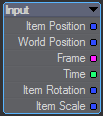The different Input nodes, where they can be found, what their outputs are.
When editing a surface, this node always appears in the Node Editor.
 | - Item ID (Integer) - The LWItemID of the intersected primitive
- Pixel X, Y (Integer) - The location of the pixel currently being rendered
- Frame Width, Height (Integer) - The resolution of the image set in Camera Properties
- Ray Position (Vector) - Origin of the ray that intersected this primitive (from the Camera, Reflection, Refraction, Shadow, etc.)
- Ray Position dX, dY (Vector) - Ray origin differentials
- Ray Direction (Vector) - The direction of the ray that intersected this primitive (from the Camera, Reflection, Refraction, Shadow, etc.)
- Ray Direction dX, dY (Vector) - Ray direction differentials
- Ray Weight (Color) The accumulated weight of the ray represented as a color
- Ray Distance (Scalar) - The distance the ray traveled before intersecting the primitive
- Shutter Time (Scalar) - The normalized shutter time (0...1)
- Ray type (Integer) - Camera ray, Reflection ray, Refraction ray, Dissolve ray, Shadow ray and Occlusion ray. These can be fed into the Ray Type Switch node.
- Ray Bounce (Integer) - The number of bounces the ray has taken to reach this intersection. Starts at 1
- World Position (Vector) - The location of the intersection in world coordinates
- World Position dX, dY (Vector) - The partial derivative of the world coordinate position in relation to X or Y coordinate of the pixel
- World Position dU, dV (Vector) - The partial derivative of the world coordinate position in relation to the U or V coordinate of the pixel (for objects with automatic UV maps)
- Perturbed Normal (Vector) - The interpolated normal perturbed by bump or normal mapping
- Smooth Normal (Vector) - The interpolated normal
- Geometric Normal (Vector) - The un-interpolated geometric normal
- Normal dU, dV (Vector) - The partial derivatives of the normal along U and V coordinates
- Barycentric Coordinates (Vector) - The masses of each vertex on a triangle
- Object Position (Vector) - The location of the intersection in local coordinates
- To Local, To World (Matrix) - Transformation matrices for the intersection
- U, V (Scalar) - The U or V coordinate for the intersection, presuming the surface has UV coordinates
- U and V dX, dY (Scalar) - The U and V partial derivatives along pixel X and Y
- Primitive ID (Integer) - A Primitive can have an ID assigned that is different to the Item ID
- Surface Side (Integer) - Determines if the intersection hit the front (0) or back (1) of the surface (2 double sided back)
- Polygon Index (Integer) - The numeric index for the polygon at the intersection
- Mesh Element (Integer) - Outputs the element type needed for the Mesh Element Switch node
|
Accessed through Motion Options > Modifiers > Nodal Motion.
 | - Item Position (Vector) - Relating to the item driving the nodal motion
- World Position (Vector) - Relating to World coordinates (Vector).
- Frame (Integer) - The current frame number (Integer).
- Time (Scalar) - The current time in the FPS set in Options (Scalar).
- Item Rotation (Vector) - Uses the current Item rotation as an output (Vector).
- Item Scale (Vector) - Uses the current Item scale as an output (Vector).
|
Accessed through Object Properties > Primitive > Modify > Nodal Displacement.
 | - Object Position (Vector) - Provides the undeformed vertex position
- World Position (Vector) - Provides the deformed position in world coordinates
- Normal (Vector) - The vertex normal
- Current Position (Vector) - Provides the current deformed vertex position in object coordinates
- Point Index (Integer) - Gives the point index of the vertex.
|
In addition, the Nodal Displacement destination node has the following options when double-clicked on:
- A Mode setting to control if the value is used to displace (add) or set the vertex position.
- Deformed Coordinates in texture nodes checkbox for object or world coordinates.
Accessed through Instance Generator > Nodes > Edit Nodes.
 | - ID Index (Integer) - The ID of each instance
- Fixed Random (Scalar) - Gives a random output
- Fixed Float (Scalar) - Gives an output relative to the quantity of instances used
- Base Position (Vector) - The base position of the instance
|
Accessed through Light Properties > Edit Nodes.
 | - Direction (Vector) - The direction in which the light is pointing
- Distance (Scalar) - A value that can be used for controlling color over distance
|
Accessed through Flocking > Flock > Properties.
 | - Position (Vector) - Final world position of the agent
- Velocity (Vector) - Speed and direction of the agent
- Bank Up Vector (Vector) - The direction of Up for the agents
|





